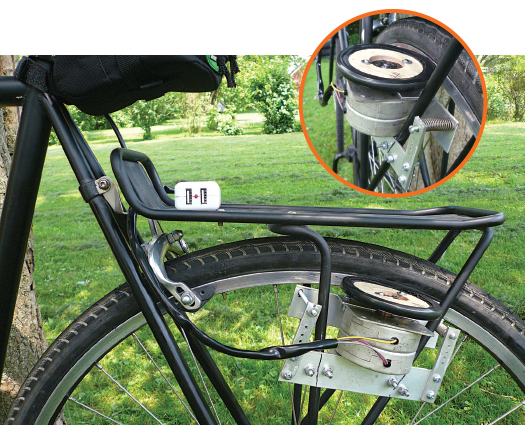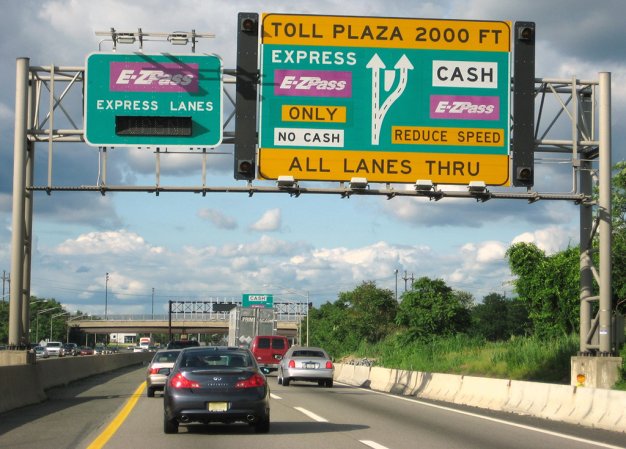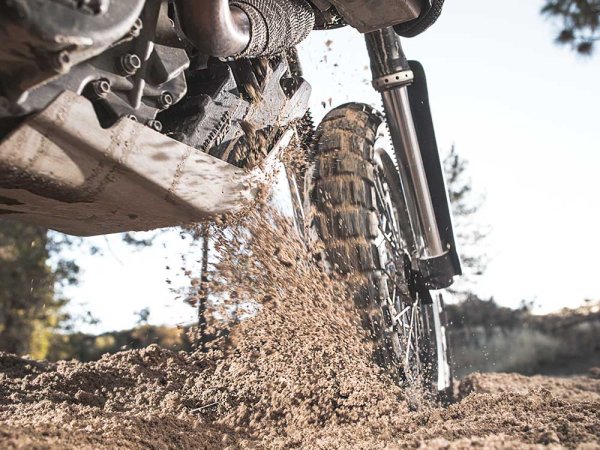

E-bikes are essentially regular bicycles with electric motors that allow riders to use pure leg power, pedal with assistance from the motor, or rely completely on the electric motor. Thanks to this motor, e-bikes are easier to ride and their owners can zip around without expending much energy (or burning gallons of gasoline). Commuters can travel to work without sweating much and shoppers can easily carry their purchases home with them.
Despite the many benefits to owning an e-bike, the average price of one is quite high; resting between $2,000 and $3,000, according to the National Conference of State Legislatures. But with a little work, you can convert your existing non-electric bicycle into an e-bike, allowing you to reap the same benefits for a fraction of the cost.
Anatomy of a converted e-bike
At a basic level, a bicycle is made up of two wheels, a frame, pedals, handlebars, and a chain. For the most basic of e-bike conversions, you’ll need to add an electric motor and batteries to the mix. More advanced kits will have a pedal assist sensor, magnetic brake cut-off switches, and an on-board computer. Here’s a brief description of what these additional components do:
- Pedal-assist sensor: Detects when you’re pedaling, and turns on the electric motor after it detects a predetermined level of pedaling intensity.
- Magnetic brake cut-off switches: Located on each brake lever, these cut power to the electric motor when you brake.
- Bike computer: Displays information such as the battery’s current charge state and how fast you’re going.
Choosing the right electric motor for your e-bike conversion
In many places, there is a limit on how fast you can ride an e-bike on public roads. In the US, the top speed of an e-bike is typically capped at around 20 mph (32 kph). Check your local regulations when purchasing your e-bike motor to ensure that you don’t buy one that will make your conversion project illegal where you live and ride.
Once that’s done, the right motor for your bike depends on a few things: whether you have a mountain bike, road bike, or hybrid bike; your bicycle’s current brake setup; and how much you’re willing to spend. With all that in mind, you have four types of motors to choose from.
Mid-mounted motor
As its name suggests, a mid-mounted motor is mounted in the middle of the bicycle frame, between the pedals. This provides a low center of gravity and the feel of a traditional bike. The position of the motor means its weight isn’t as noticeable. Its central placement away from the wheels also means tire repairs will be easier—the other types of motors tend to get in the way of tire changes. It’s also attached to the bike’s gearing system, leading to longer, more efficient rides per charge if you use pedal assist. But while its excellent weight distribution makes a mid-mounted motor the best choice for road cyclists, this type does have some drawbacks. For one, it is more expensive (usually from $275 to $400). Its low mounting location also increases its risk of hitting obstacles, which could cause issues for riders who want to take their bikes off-road.
Side-mounted motor
This type of motor is usually bolted to the left wheel of the bicycle (on the opposite side of the gearing sprockets). It’s a simple setup where the motor drives the rear wheel using a secondary chain. This is the cheapest motor option (around $86 to $165), and while it won’t result in the fastest e-bike, it will get the job done. If you want to cut down on cost, this is the motor for you.
Rear-wheel hub motor
These motors are integrated into the hub of the rear wheel. Installation will be more complicated because you’ll need to remove the gear cassette to take off the wheel and attach the motor. With that said, the overall ride quality is generally better with a rear-wheel hub motor than with a front-wheel hub motor. With a front-wheel hub motor, there is a risk of traction problems. Hub motors also tend to be brushless, so they typically perform better than brushed motors (common in side-mounted motor kits). Rear-wheel hub motors are also a little more stealthy in terms of aesthetics since they are hidden by the gear cassette. The price range of a rear-wheel hub motor is between that of a side mounted motor and a mid-mounted motor (ranging from $183 to $240).
Front-wheel hub motor
This setup is similar to a rear-wheel hub motor, but the motor is integrated into the front wheel’s hub. They allow for easier repairs than rear-wheel hub motors since you don’t have to worry about moving the chain out of the way when making repairs. These motors are also usually brushless. Like rear-wheel hub motors, front-wheel hub motors go for between $183 and $240.
L-faster on AliExpress is a good source of e-bike motor kits (not including batteries), and Battery Clearing House has great deals on wheel hub motor kits since they source them from bikes that were previously used commercially. Also, feel free to peruse Amazon and Aliexpress for kits since there are usually solid prices on kits from these two sources.
How to select batteries for your e-bike conversion
These days, with the proliferation of electric scooters, electric bicycles, electric skateboards, and other electric modes of transportation, batteries are readily available. There are many to choose from, but lithium-ion batteries are the best choice for an e-bike conversion. The easiest way to get your hands on some is to use battery modules that were intended to be used with one of the electric transportation devices mentioned earlier. Some retailers even sell used batteries that are in excellent condition.
[Related: One tell-tale sign it’s time to replace your laptop battery]
Since motors usually are rated for 24, 36, or 48 volts, you will need a battery module that has a matching voltage. When buying battery modules, you have the option to get multiple battery packs with this voltage, and you can connect multiple packs with the required voltage to increase the capacity of your final battery module.
While it is possible to assemble a battery module from individual 18650 lithium-ion battery cells, this is complicated and will require spot welding and buying a battery management system. It’s much easier to purchase a pre-assembled pack from a website such as AliExpress or Battery Hookup. However, if you have the skills and are up for the challenge, EBikeSchool.com has an excellent tutorial on how to build your own battery pack if you’re interested in making one from scratch. The batteries within a battery pack, or group, are wired in series, and these groups are then wired in parallel to create a single module.
Don’t forget: You will also need a charger to go along with your batteries. You can use the following equation to determine the voltage of the charger you need:
Number of batteries in series in a single battery pack x 4.2 volts = charger voltage
This means that for a 24-volt battery pack, which uses groups of seven, 3.7-volt 18650 lithium-ion batteries in series, you will need a 29.4-volt charger. For a 36-volt module, which uses 10 such cells in series, you will need a 42-volt charger. Finally, for a 48-volt battery module, which uses groups of 13 18650 cells in series, you will need a 54.6-volt charger.
You can buy chargers on sites like Amazon or AliExpress. Check these postings for the most common battery configurations:
- 29.4V charger for 24V battery packs
- 42V Charger for 36V battery packs
- 54.6V charger for 48V battery packs
You will also need to think about where you want to mount your e-bike battery. These are the options:
- Rear cargo rack: If your bike doesn’t already have one of these, you can install one and mount your batteries there. However, this could negatively affect the handling of your bike, especially if the motor is mounted in the back as well—the added weight of the batteries shifts the bicycle’s center of gravity more toward the rear.
- Triangle mount: For bikes with hard tails, there is a relatively large triangular space between the bike’s frame tubes. You can buy a triangle frame bag to put your batteries in and hang in this area. This spot is a good option if you want to maintain a reasonable center of balance.
- Top tube mount: This is yet another option for not offsetting the center of balance of your bike too much. There are bags available that you can mount to your bike’s top tube. You can easily store your batteries in one of these bags.
The bike you build determines how far you’ll go
There are a few factors that determine the range of an e-bike. The battery capacity certainly matters, but so do your speed, the terrain, your weight, and the type of tires you’re using.
These factors naturally vary between different owners and bikes. Since we’re talking about a DIY project here, it’s hard to say what the exact range will be. But if you get a battery with a capacity of more than 300 watt-hours, you should have a range of roughly 15 miles (24 kilometers). Every mile (1.6 kilometers) should use up about 20 watt-hours.
With this knowledge in mind, you’re well on your way to building a DIY e-bike that will get you where you need to go in a sustainable, enjoyable way. Putting it together is only the beginning.
Update, January 26, 2022: An earlier version of this story was unclear about how the batteries are connected. We have updated the story to clarify.


![DIY: How To Light Up Your Bike Wheels [Video]](https://www.popsci.com/wp-content/uploads/2019/03/18/5W3D4XGHTUCZJ7MDSNH5FIATSY.jpg?quality=85&w=506)
![When Disaster Strikes, This Bike Generator Will Give Me Power [Video]](https://www.popsci.com/wp-content/uploads/2019/03/18/PUHYEFLNLZ4QPOMBEFNJF6IXOU.jpg?quality=85&w=525)











